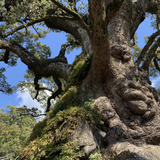Ylang Ylang Extra
Cananga odorata v Genuina
Annonaceae family
Ylang ylang is part of the annonaceae family and they are related to that green fruit with soft white flesh called either cherimoya, custard apple, guanaba, or sour sop.
Ylang ylang is very “important” in many ways—first, it’s a magnificent, strong and luscious floral, indispensable in both perfumery and aromatherapy. It’s also comparatively affordable, which is not always the case with great florals. Some consider ylang ylang to be a more affordable jasmine
Ylang Ylang and jasmine don’t really smell that similar….It’s a magnificent oil in its own right, and no need to compare them. Ylang Ylang’s character and attributes stand on their own, and does not depend in any way on it being a cheaper or somehow second best version of jasmine.
We have two: Ylang Ylang extra and Ylang Ylang complete.
They are both super beautiful and both from one of Ylang Ylang’s preferred terroires, the Northern Madagascaan island of Nosy Be. Ylang Ylang does grow, however, in many other rainforest ecosystems, and islands in the Indian and Pacific ocean, in particular Reunion, the Comoros Islands, Micronesia, Melanesia and Polynesia. The tree is native to Indonesia and the Philippines
Ylang Ylang
A Poem by Ric Bastasa
Tonight the ylang-ylang blooms
amidst the darkness and the rain
spreading its scents
still sweetest to my smell
you are still the ylang-ylang that
i once kissed.
In my rain and darkness
you still bloom best.
Let’s see how Arctander describes it
In general, he says a good quality ylang ylang need not be compared to any other oil. It is so unusual in itself, so simple and yet so complex of odor, so genuinely popular a fragrance, that it easily finds its own place in perfumery, not merely as replacement for jasmine, but as an improvement on almost any type of floral fragrance.
The oil is produced by water or steam and water distillation from freshly cut early morning picked flowers. All Ylang Ylang oil is today produced from flowers of cultivated trees.
Ylang Ylang distillation is carried out in small stills, since the weight of all the plant material would adversely impact the scent if larger stills were used. The distillation is interrupted, by fractionating, with the first fraction collected separately after a short amount of time, the second fraction after a longer distillation period, and finally the third fraction.
The classification of these fractions is based on the specific gravity for each, with specific parameters set. The specific gravity of the first distillate usually starts over 1000 and it decreases as the distillation progresses and in each fraction thereafter. The first fraction is called “extra” and the specific gravity is somewhat standardized at 0.975-0.985 but this is not necessarily a guarantee of genuineness.
The first distillation, the “extra”, is the first 30-45% of the total distillatate, followed by the Ylang Ylang First, Ylang Ylang Second and Ylang Ylang third.
Battaglia notes: There is also sometimes an “Extra-superior” fraction taken from the first half hour of distillation.
Acrtander says (as of 1960) that demand was only for the Extra grade, and the third grade, which was used to replace and bolster Cananga oil. He says first and second grade were combined to make Ylang Ylang extra, but we do know Ylang Ylang extra as a combination of all the grades.
Arctander on Ylang Ylang Extra
Ylang Ylang Extra is a pale yellow oil with a very powerful, floral and intensely sweet odor and a cresylic and benzoate-like topnote of limited tenacity. The fadeout is more pleasant, soft and sweet, slightly spicy and balsamic-floral. A high grade Ylang Ylang extra oil resembles Ylang Ylang absolute in very closely with a peculiar, creamy-sweet note characteristic of Ylang Ylang Extra. This suave, soft and persistent note is very difficult to reproduce in artificial Ylang Ylang oils.
Ylang Ylang Extra is used mainly in high class perfumes of the floral and heavy-oriental type, but mere traces of the oil can do wonders in medium priced floral bases. There is hardly any floral type where Ylang Ylang Extra would not fit in.
The oil blends excellently with rosewood, vetiver , opoponax, bergamot, mimosa, rose absolute, cassie, and Peru Balsam.
Safety Warning
As with most essential oils, dilute before using on skin. Perform a patch test before use if essential oil sensitivity is suspected. Do not take essential oils internally. Do not use on children or pets. Seek advice from a trained aromatherapist before using on people with compromised immune systems. Keep away from eyes and mucus membranes.
Enfleurage makes no medical claims relating to any products, essential oils or otherwise, on our website or through social media. We are an essential oil company, not doctors, The FDA has not evaluated the statements on this website. We present our information in order to educate our customers on traditional and general uses of essential oils; in no way do we diagnose, cure, treat, or prevent any disease or condition.
You the customer are responsible for understanding the safe use of any and all of our products, including essential oils, and use them accordingly.
2.12.0.0
2.12.0.0
















